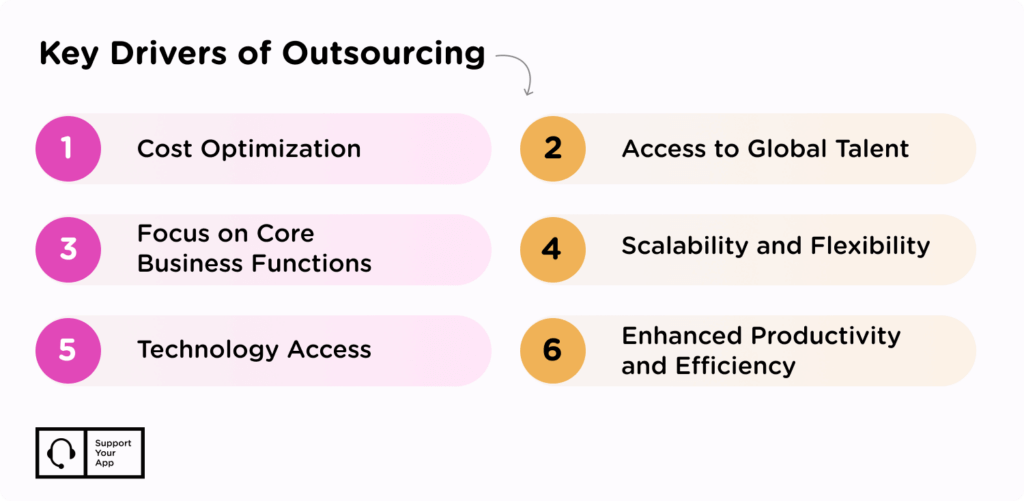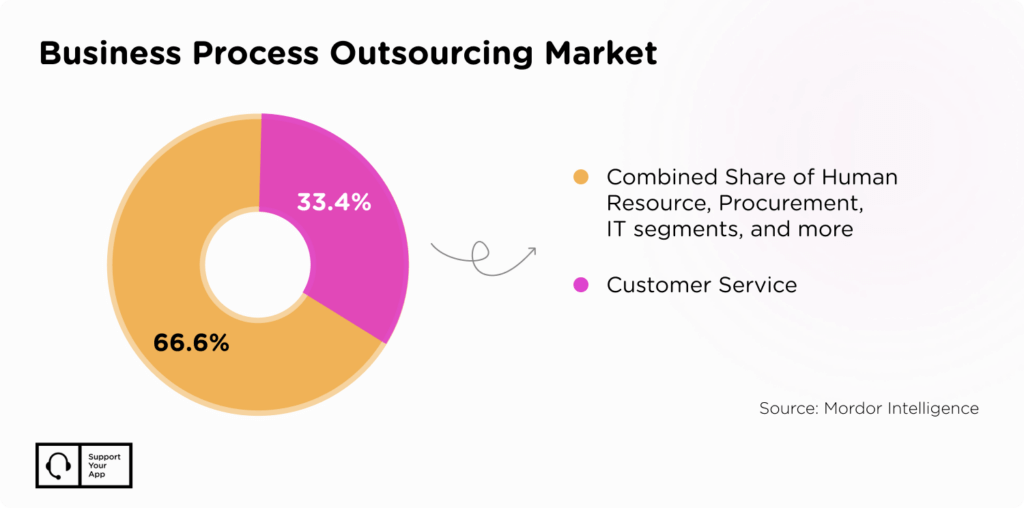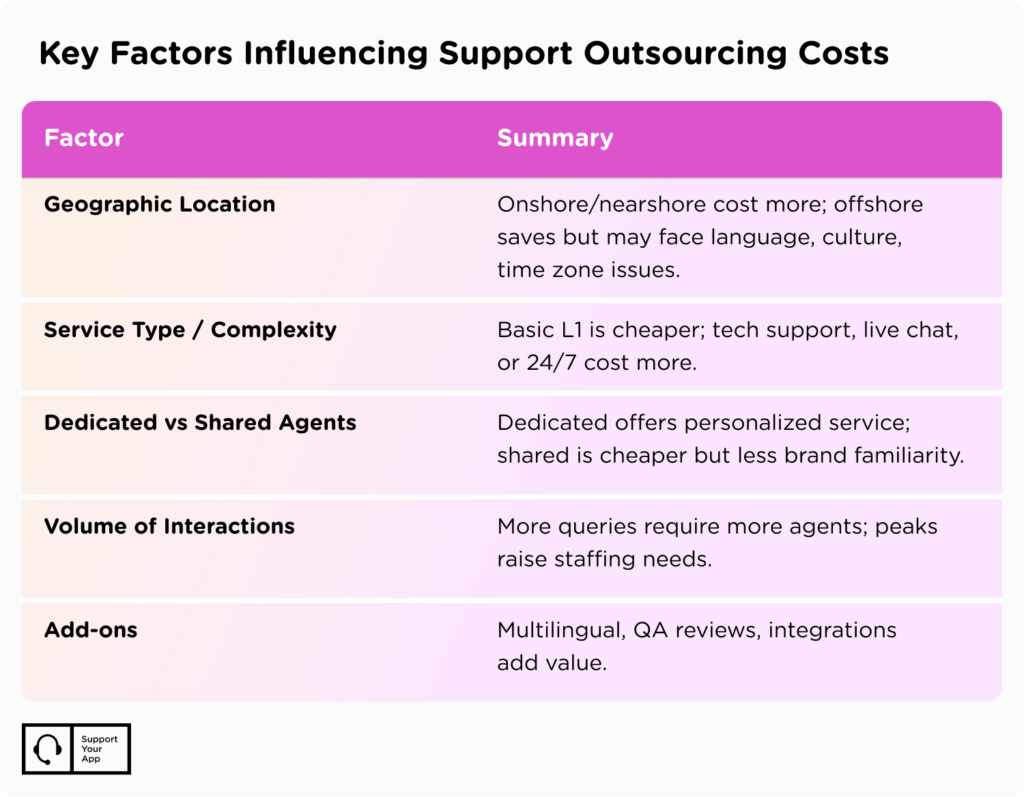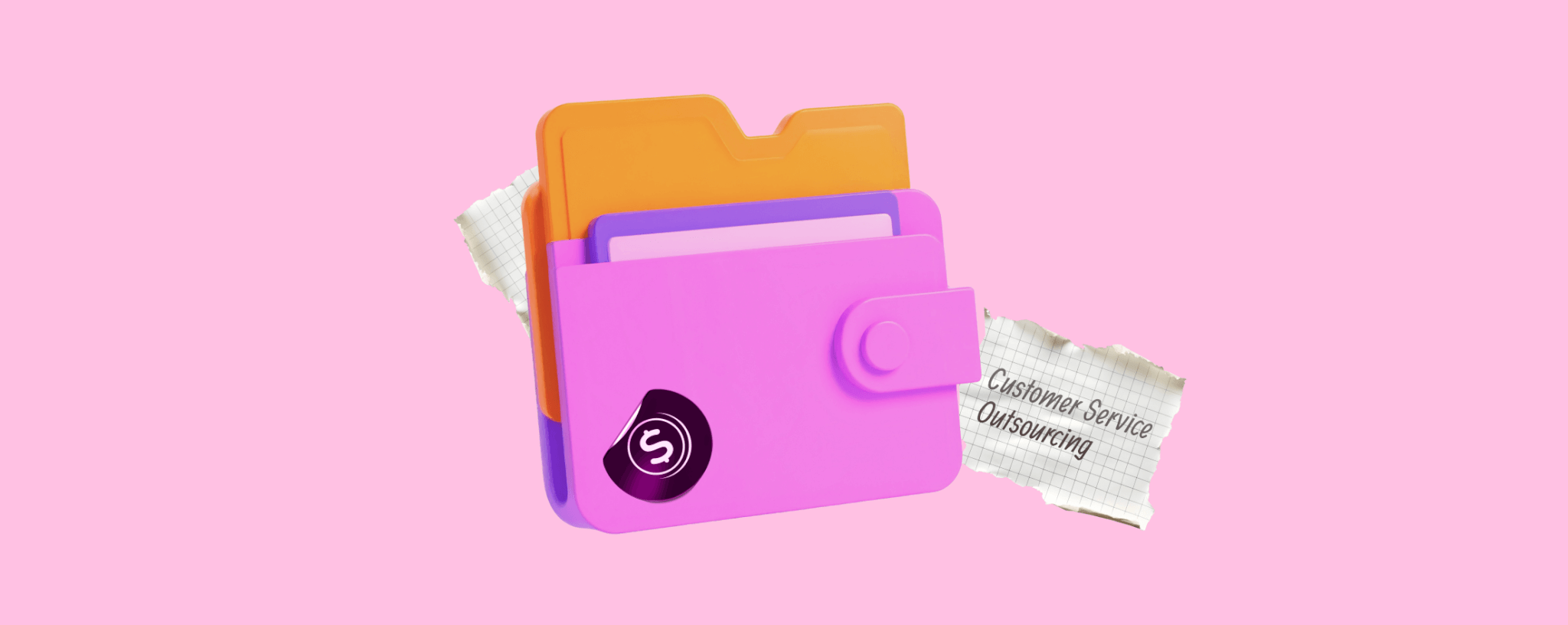Up to 80% of businesses globally outsource at least one function. For customer support specifically, outsourcing can reduce costs by as much as 83%. That’s a good reason to employ an external provider for support, right?
Building an in-house support team, on the other hand, presents significant challenges. You still have to navigate various customer service outsourcing cost models. You also have to consider geographic factors like time zones, labor costs, and compliance with local regulations. Then, there’s choosing which service channels will best meet your customers’ needs. Outsourcing support gives you the flexibility to focus on your core business, while your provider manages support tickets efficiently.
Here are some other compelling benefits of outsourcing, as shown in the diagram below.

- Cost Optimization: Outsourcing removes costs of hiring, training, and managing in-house teams, plus infrastructure expenses, allowing reinvestment elsewhere.
- Ease of Scalability: As your customer base grows, outsourced support can adjust quickly to avoid bottlenecks.
- Access to Global Talent: Outsourced customer service companies train their agents regularly to keep up to date with the latest trends and best practices.
- Focus on Core Business Functions: Most importantly, by not having to focus on customer support, you can pour your time and effort into doing what you do best: running your company.
Customer Service Outsourcing Pricing Models
When you outsource customer service, the provider’s pricing model plays a key role in determining how much they will charge and the quality of service you receive.
So how can you understand the true cost of support? While rates vary by company and model, the following pricing structures offer insight into how the outsourcing fees are typically calculated:
Flat Rate Model
While less common today due to the evolving nature of modern businesses, this model means a vendor will charge you fixed rates per month. Flat rate answering offers predictable costs, making it ideal for businesses with steady support demand and strict budget limits.
Per Minute/Per Hour Model
With this model, the cost of outsourcing customer service is based on the amount of time agents spend working on resolving support issues. A fixed rate is paid per minute or per hour of support provided, regardless of call volume.
Shared Agent Model
A pool of agents is shared across multiple clients, ultimately resulting in lower costs compared to a dedicated team. This is usually suitable for companies with a low call volume.
Dedicated Agent Model
If you want a team exclusively trained on your brand, products, and services, then this one is for you. Although more expensive than other models, it provides more control and consistency.
SupportYourApp offers four different pricing packages, each providing a different level of support with variations in team size, language options, multichannel coverage, analytics, and overall service complexity.
For example, our most basic Essential plan offers a shared team of four agents with limited language capabilities and L1 complexity, while our Enterprise plan consists of over 100 dedicated agents with the option to tailor your plan according to your company’s support needs across the board.
Key Factors That Influence Customer Support Outsourcing Costs
An outsourced call center has become an increasingly popular option in modern companies. This is evident in a study conducted by MordorIntelligence, in which 33.4% of the Business Process Outsourcing (BPO) Market consists of customer service alone, as depicted in the graphic below.

Beyond its market share, several key elements can significantly impact the customer service outsourcing costs.
1. Geographic Location
Location is one of the biggest factors influencing the cost of outsourced support. Onshore or nearshore contact centers, being closer to the company, typically cost more than offshore options.
However, while offshore centers save money, factors like language and time zone differences can affect service quality, so it’s important to find the balance that best suits your company.
2. Type of Support
The type of support services you require greatly affects outsourcing costs. For instance, IT support pricing will generally be higher than standard customer support pricing due to the greater technical complexity involved. While basic L1 customer support (emails and calls) is more affordable, specialized services like technical support or live chat, and especially 24/7 coverage, will increase the overall rate.
3. Dedicated vs Shared Agents
A dedicated support team is more expensive. Such a team will provide your customers with undivided attention and a more personalized service, while shared agents might have slower response times or be less knowledgeable in your product.
However, using a dedicated team if you have a low call volume might be a costly choice, so think carefully about your exact service needs before making a decision.
4. Volume of Interactions
The number of queries your company receives will also impact your final cost because it will determine the number of agents you need at a point in time. This can change during peak seasons and should be budgeted for ahead of time.
5. Additional Services & Add-Ons
Additional services can also drive up the cost of outsourcing customer service. These may include multilingual proficiency, quality assurance assessments to identify weaknesses and opportunities for improvement, or the use of advanced integration tools. Each of these extras can increase the final price charged.

Customer Service Outsourcing Cost by Region
How much would outsourcing customer service cost for your business? Consider the geographic location as it’s one of the key factors when selecting an outsourced provider. Onshore and nearshore providers, such as those in North America, Western Europe, or Australia, are typically more expensive, largely due to higher labor costs and closer cultural alignment with your customer base.
Offshore providers, such as those in the Philippines or India, are often more cost-effective, making them a popular choice for businesses seeking greater savings. However, lower costs should be weighed against considerations like language proficiency, time zone overlap, and cultural fit to ensure a high-quality customer experience.

Reducing the Costs of Customer Service Outsourcing
If you’d like to reduce call center costs, start with making smart choices about location and resources. Offshore providers in lower-cost regions can offer substantial savings, provided you ensure strong language skills and cultural alignment. Switching to cloud-based solutions can also cut infrastructure and maintenance expenses, while better call center forecasting helps align staffing levels with actual demand.
Cost control also means paying only for what truly benefits your operation. Avoid expensive software tools unless they directly add value, and match agent skill levels to the complexity of your support needs so you’re not overpaying for unnecessary expertise. For businesses with lower call volumes, shared agents can be a cost-effective alternative to dedicated teams, helping you maintain quality service without the overhead of underused staff.
Ultimately, when you decide to hire a call center, the most critical step should be exploring all the use cases for your customer support team and defining your needs.
Summary
Outsourcing has become increasingly popular in modern businesses, particularly in the customer support sector, due to factors such as cost optimization, scalability, access to expert agents, and the opportunity to invest and focus on core business functions. Customer service outsourcing cost is influenced by numerous factors, including pricing models, location, service type and complexity, agent type, and volume, to name a few. The region in which the call center operates is a particularly large influential factor, as it determines the average cost rate and the cultural and language in which your customer base will be serviced. There are, however, ways to reduce call center cost to better fit your budget without compromising quality or customer satisfaction and still meeting your targeted metrics.
FAQs
How Much Does It Cost to Outsource Customer Service?
The cost to outsource customer service depends on factors like location, service complexity, support hours, and whether you use dedicated or shared agents. Pricing models also vary between providers, so the final amount will reflect your specific requirements and the level of quality you expect.
Which Factors Affect the Cost of Outsourcing Support?
Factors that affect the cost of outsourcing support include the provider’s pricing model, the volume of customer interactions, and any additional services or tools you choose. Elements like training requirements, language capabilities, and integration options can also influence the final price.
Is Outsourcing Customer Service Cheaper Than Hiring in-House?
In-house customer support requires hiring and training agents, plus investing in infrastructure, equipment, and software. These expenses are also accompanied by additional overhead costs like utilities and salaries. By contrast, when outsourcing, the vendor takes on all of these responsibilities, concluding that, in most cases, outsourcing is cheaper than running an in-house operation.
What’s the Best Country to Outsource Customer Support To?
The best country to outsource to depends on your company’s specific needs. If language and culture are important aspects to support, then the company would be better off choosing an onshore or nearshore vendor than an offshore vendor. However, if these factors are not that important and the business is looking to optimize costs, then it would be best to choose an offshore vendor based in a country like the Philippines or India, where rates are cheaper.
❤︎ Like it? — Share: Share on LinkedIn or Share on Facebook

Nader is an Integration Specialist with over nine years of experience in the customer support industry. Having started as a support agent, he developed a deep understanding of diverse client needs and service environments. He now specializes in building and optimizing helpdesk systems, creating workflows, and implementing tailored integration solutions. Outside of work, he enjoys watching anime, spending time with his family and friends, and is passionate about brewing and tasting great coffee.
Posted on


 LinkedIn
LinkedIn

